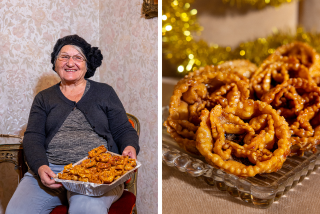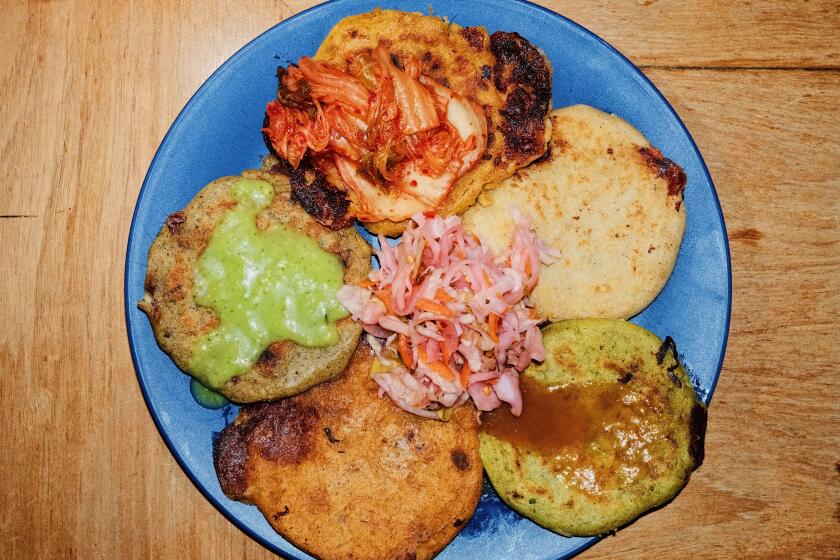Italian Macaroons Make Use of Almond Paste
Question: I’d had no luck in finding a recipe using almond paste until someone told me to use it in cookies. Would you have such a recipe?
Answer: Here’s one for Italian Macaroons that uses a cup of the paste.
ITALIAN MACAROONS
1/2 cup granulated sugar
1/2 cup powdered sugar
1 cup almond paste
1 tablespoon flour
2 egg whites
Combine granulated and powdered sugars. Cut in almond paste with pastry blender until mixture is crumbly. Stir in flour. Stir in egg whites, small amount at time.
Drop mixture by teaspoons or pipe through pastry bag onto parchment-lined baking sheets. Bake at 400 degrees 8 to 10 minutes or until lightly browned. Makes about 3 dozen.
Q: What does it mean when a recipe tells you to “deglaze” a pan? How do you do it?
A: Basically, deglaze means to loosen drippings from the bottom of a roasting pan or skillet by adding a liquid.
In “The Essential Cook” (Hill House Publishing, 1989: $24.95), author Charles Delmar explains: “Any cooking vessel in which meats or poultry are fried, roasted or baked will contain tasty pan drippings. Those pan drippings as well as the fat and liquid in the vessel can be used to flavor gravy. All that is required is to dissolve the pan-drippings into the fat or the liquid that will be used to make the sauce. Here’s how to do it.
“To the liquid from the pan, add enough liquid to make the gravy. (Figure one-quarter cup liquid per serving.) Use broth, water, milk, wine or combinations of these.
“Pour the liquid into the pan and heat it, stirring the pan drippings to dissolve them.
“Strain the liquid into a heat-proof container through a fine-mesh tea strainer to remove unattractive food particles.
“Remove any fat from the surface of the liquid and use it to make the roux to thicken the gravy.”
Q: I was shopping recently in the Little Saigon area of Westminster and saw a strange looking item in the produce section of one of the supermarkets. It was called a durian. Can you tell me anything about it?
A: According to “Exotic Fruits A--Z” (Salem House Publishers, 1988: $14.95) by Josephine Bacon, durian “is notorious for its pungent and rather nasty smell, which is in contrast to the sweet, pleasant taste of its flesh. It is highly prized in Southeast Asia and also grows in East Africa. Because of the smell, it is rarely exported in fresh form, but is often seen canned and incorporated into cakes and cookies.
“The fruits are large, weighing as much as 10 pounds, and are completely covered in grayish-yellow spines. The flesh is creamy-yellow and encloses up to six large brown seeds. The flavor is so delicious that it completely makes up for the obnoxious smell.”
Bacon goes on to write: “It is advisable to eat fresh durian immediately, as the smell will pervade the refrigerator or anywhere else you keep it, but the pulp can be frozen in a plastic bag and will then be odorless. It can be made into fruit salad or stewed.”
In response to the April 27 You Asked About . . . column on orzo, T. Bernard of Los Angeles writes: “I used to purchase it at an Italian market that was quite a distance from my home. About two months ago I was shopping in the pasta section of my local market and noticed a product called Rosamarina that looked just like orzo. I tried it and it is orzo by a different name.
Since supermarkets are closer to most of us than are Italian markets, I thought you might like to pass this information along to other readers.”
Address questions on food preparation to You Asked About . . ., Food Section, The Times, Times Mirror Square, Los Angeles 90053. Personal replies cannot be given.
More to Read
Eat your way across L.A.
Get our weekly Tasting Notes newsletter for reviews, news and more.
You may occasionally receive promotional content from the Los Angeles Times.










